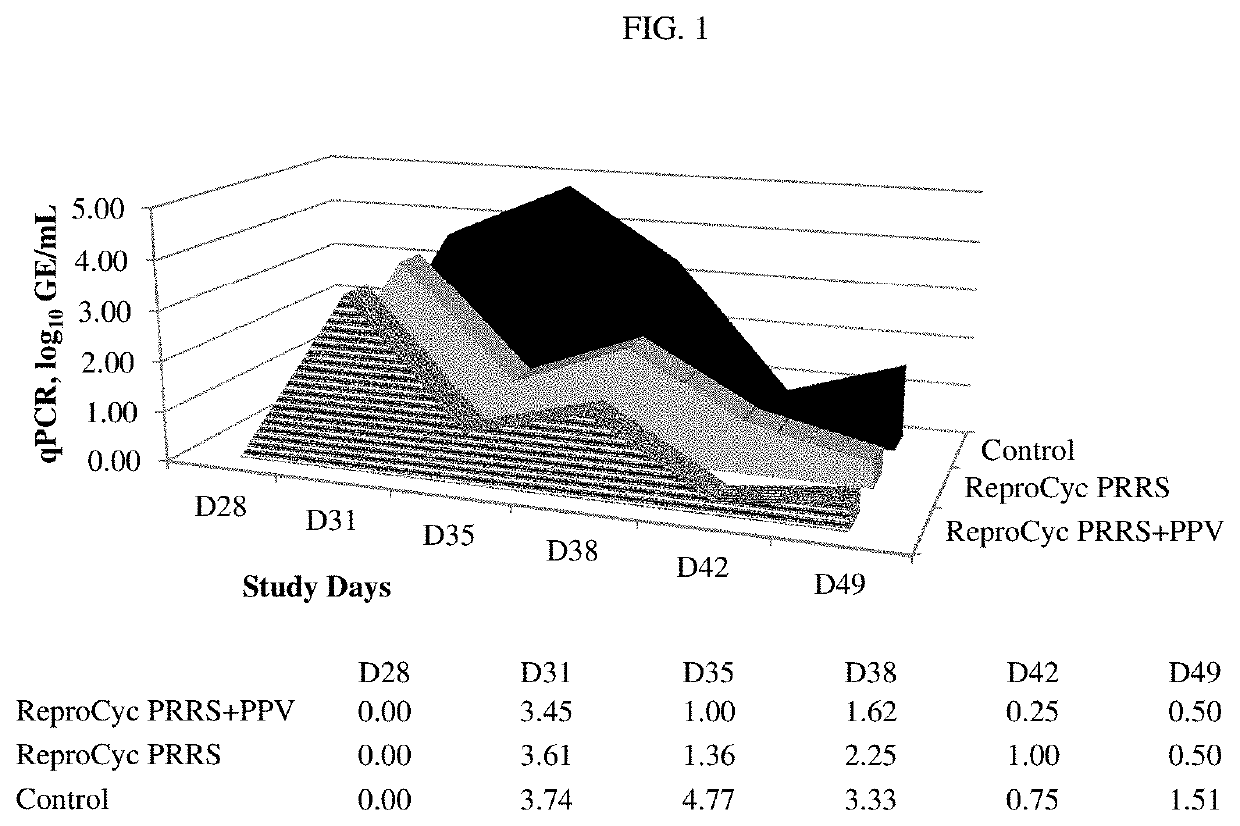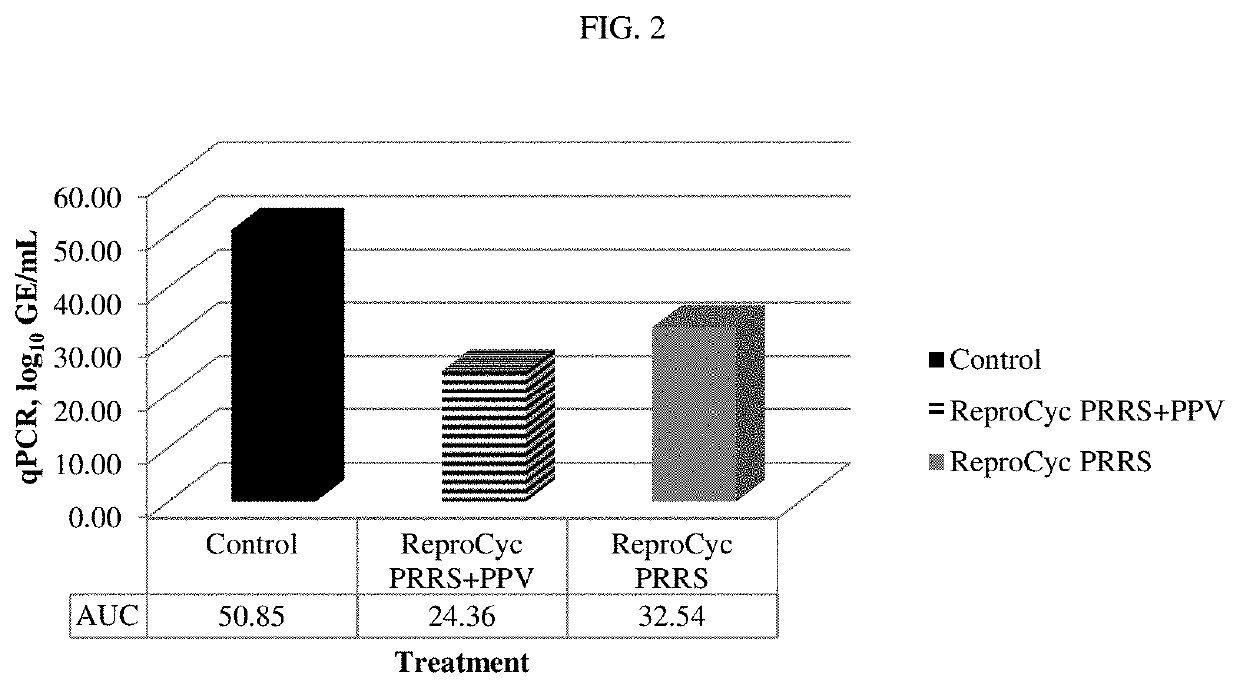Vaccine against porcine parvovirus and porcine reproductive and respiratory syndrome virus and methods of production thereof
a technology of porcine parvovirus and vaccine, which is applied in the field of vaccine against porcine parvovirus and porcine reproductive and respiratory syndrome virus, can solve the problems of complicated infection of porcine parvovirus (ppv), reproductive failure of breeding pigs in the world, and achieves the effects of reducing the number of vaccine injections, broad protection spectrum, and preventing viremia and ppv infection in fetuses
- Summary
- Abstract
- Description
- Claims
- Application Information
AI Technical Summary
Benefits of technology
Problems solved by technology
Method used
Image
Examples
example 1
Production of Porcine Parvovirus (PPV) 27a VP2—Upstream Processing
[0452]The PPV 27a VP2 was produced in baculovirus-infected SF+ cells, and is BEI-inactivated in a process somewhat similar to that of PCV2 ORF2 (WO 2006 / 072065; Examples 1 to 3). However, the PPV 27a VP2 uses a different baculovirus backbone designated as “DiamondBac” (Sigma Aldrich, D6192) (instead of the older BACULOGOLD® backbone used for PCV2 ORF2).
[0453]Porcine parvovirus (PPV) 27a VP2 nucleotide sequence was obtained from Genbank Accession AY684871.1. The PPV 27a VP2 coding region was reverse-translated and codon-optimized for Drosophila using the SCITOOLS® Web Tools software provided by Integrated DNA Technologies. The codon-optimized PPV 27a VP2 gene was further modified to insert two ClaI restriction enzyme sites into the VP2 coding region, along with the addition of BamHI and NotI restriction enzyme sites to the 5′- and 3′-ends, respectively. The ClaI sites are inserted in a manner so as to not disrupt the V...
example 2
Production of Porcine Parvovirus (PPV) 27a VP2—Downstream Processing
[0454]Two consecutive steps are followed to comprise the downstream processing. The removal of cell debris occurs in the process known as “clarification”, while the removal of media components is achieved through two volumes of wash phosphate buffered saline (WPBS), called “diafiltration”.
[0455]PPV 27a VP2 Baculovirus-vector is produced in bioreactors. The medium is added pre sterilized or sterile-filtered into the bioreactor. The medium is added with SF+ cells originating from expansion cultures. The cells are simultaneously inoculated (concurrent infection) upon planting with PPV 27a VP2 Baculovirus seed. Throughout the virus propagation temperature is maintained at 27±2° C. and pH is monitored. Dissolved Oxygen (DO) is controlled by sparging cleaned-compressed air, and oxygen (O2). The harvest window occurs between 6 to 8 days after virus infection and the harvest criterion of ≤20% Cell Viability is achieved. At ...
example 3
PRRSV-EU Vaccine Effectiveness when PRRSV-EU Vaccine is Mixed with PPV VP2 Vaccine
[0462]Thirty six (36) non-pregnant, breeding-age gilts were randomized to three treatment groups, each group comprising twelve gilts. Group T01 received control product of WPBS (wash phosphate buffered saline) (control) on days 0 and 21 (D0, D21). Group T02 received REPROCYC® PRRS EU® (PRRS Strain 94881), 3.9 log 10 TCID50 per dose, and Porcine Parvovirus vaccine, PPV-27a VP2, 10 μg per dose (mixed) on D0 and PPV-27a VP2, 10 μg per dose, only on D21. The REPROCYC® PRRS EU® as a lyophilized cake was reconstituted with the liquid PPV-27a VP2. Group T03 received REPROCYC® PRRS EU® (alone) on D0. Treatments were formulated so that gilts received REPROCYC® PRRS EU® at the minimum immunizing dose and PPV-27a VP2 at the maximum relative potency. Gilts were challenged with 5.5 log10TCID50 / 6 mL total dose (2 mL intramuscularly and 2 mL per nostril) heterologous PRRSV EU isolate 190136 four weeks after initial v...
PUM
| Property | Measurement | Unit |
|---|---|---|
| diameter | aaaaa | aaaaa |
| pore size | aaaaa | aaaaa |
| temperature | aaaaa | aaaaa |
Abstract
Description
Claims
Application Information
 Login to View More
Login to View More - R&D
- Intellectual Property
- Life Sciences
- Materials
- Tech Scout
- Unparalleled Data Quality
- Higher Quality Content
- 60% Fewer Hallucinations
Browse by: Latest US Patents, China's latest patents, Technical Efficacy Thesaurus, Application Domain, Technology Topic, Popular Technical Reports.
© 2025 PatSnap. All rights reserved.Legal|Privacy policy|Modern Slavery Act Transparency Statement|Sitemap|About US| Contact US: help@patsnap.com



